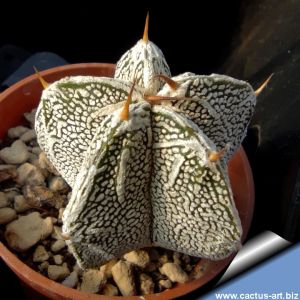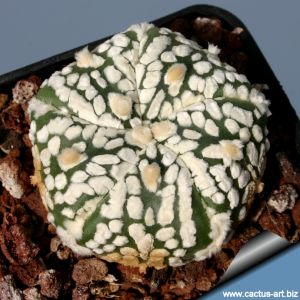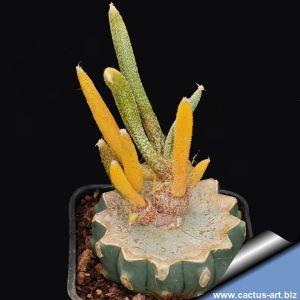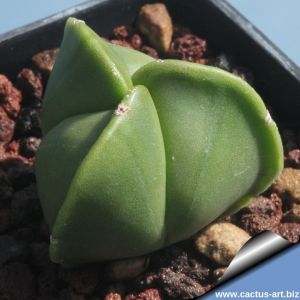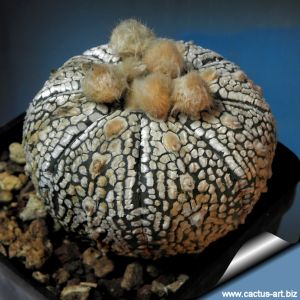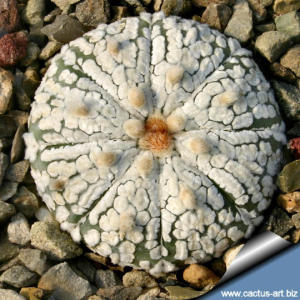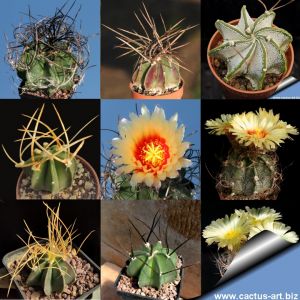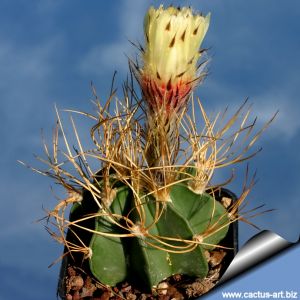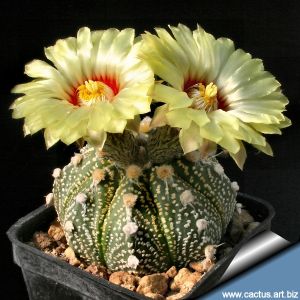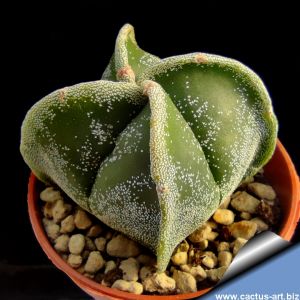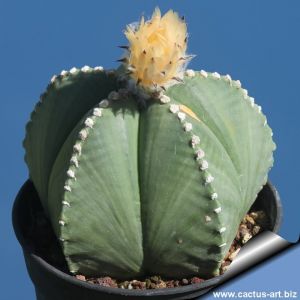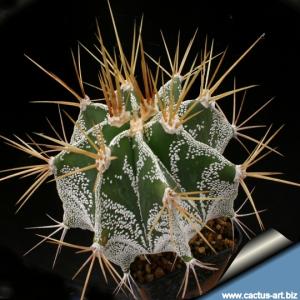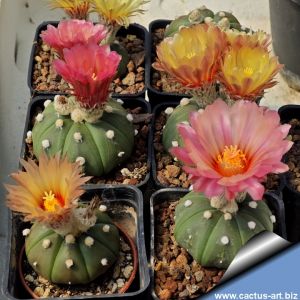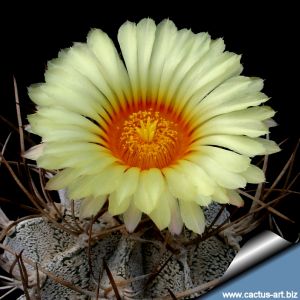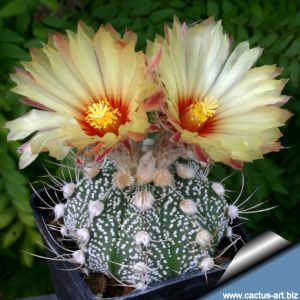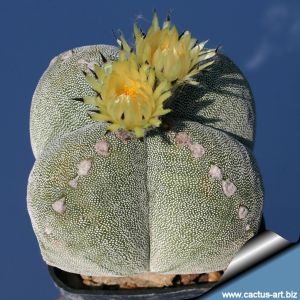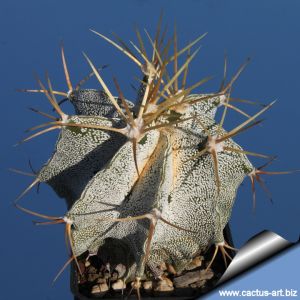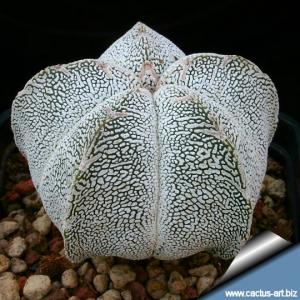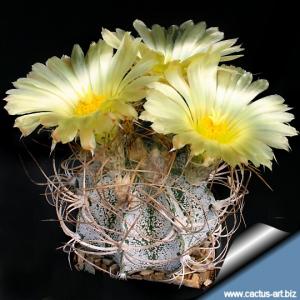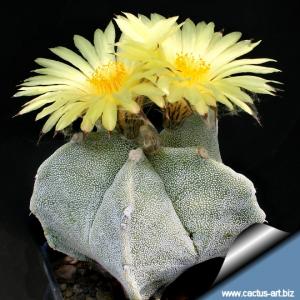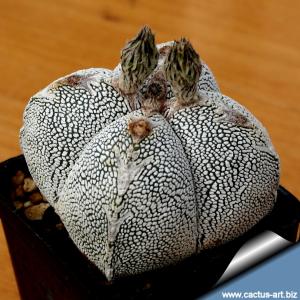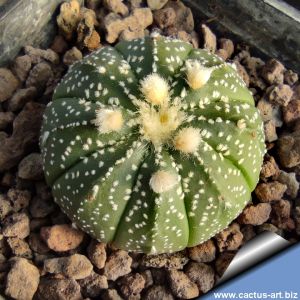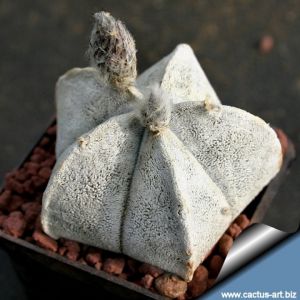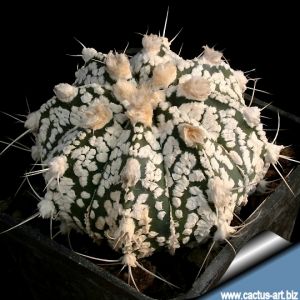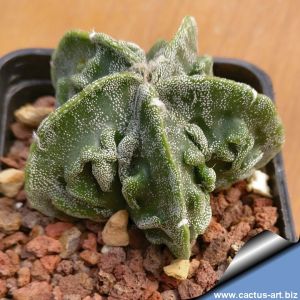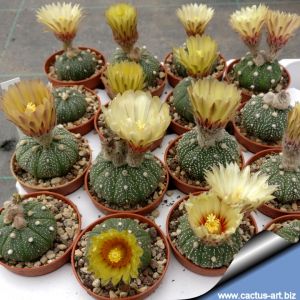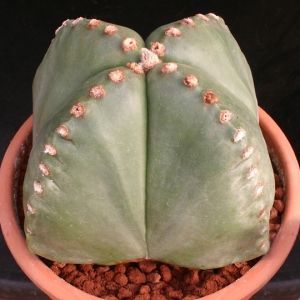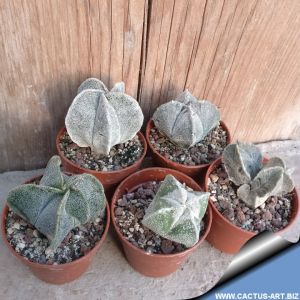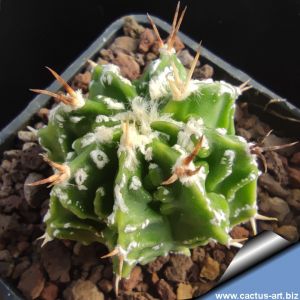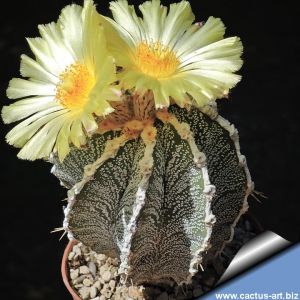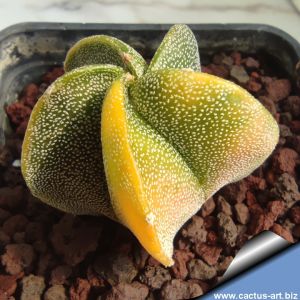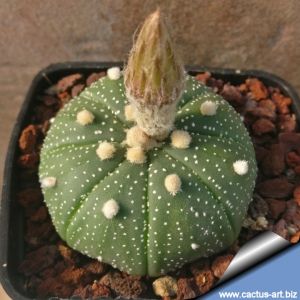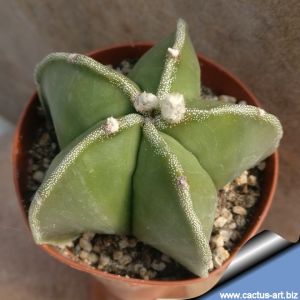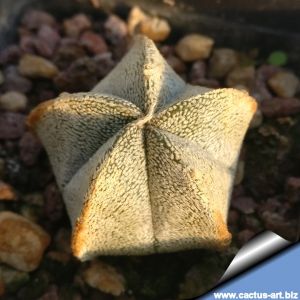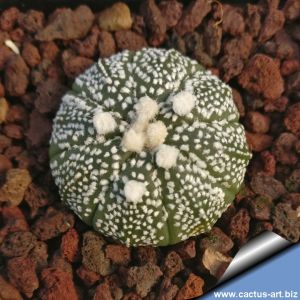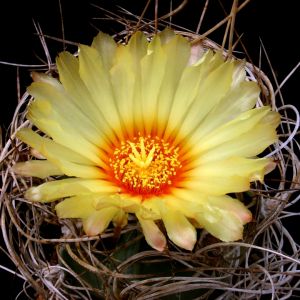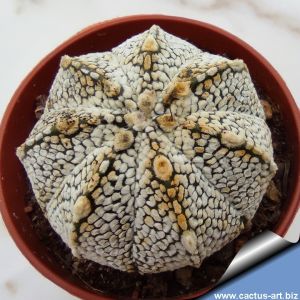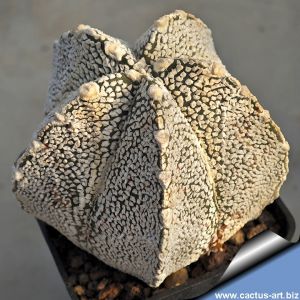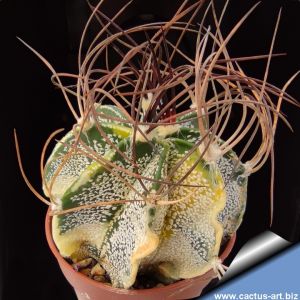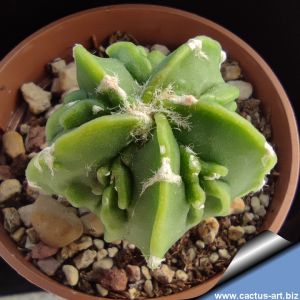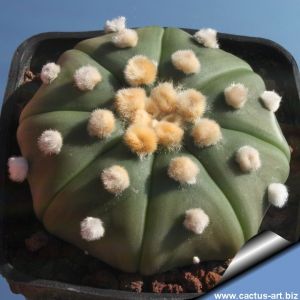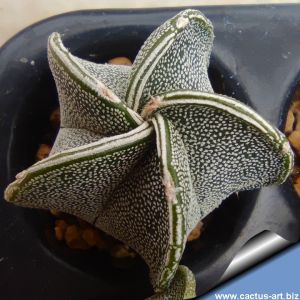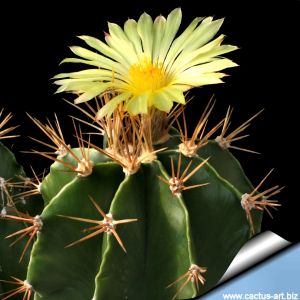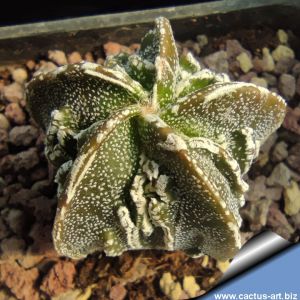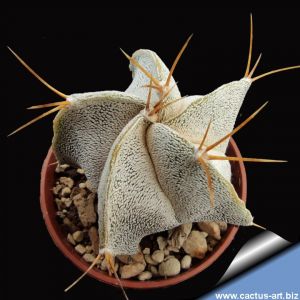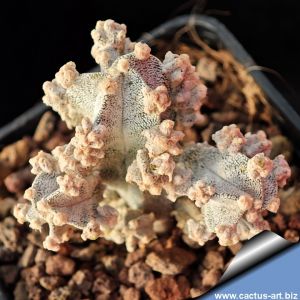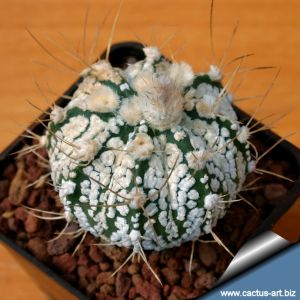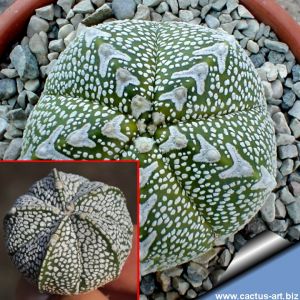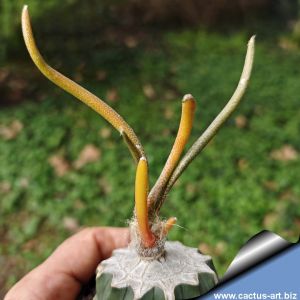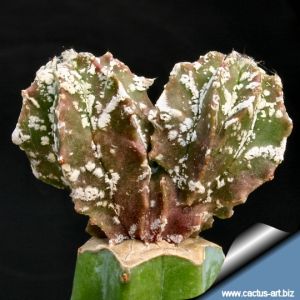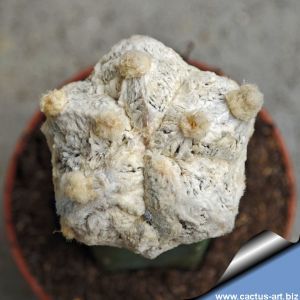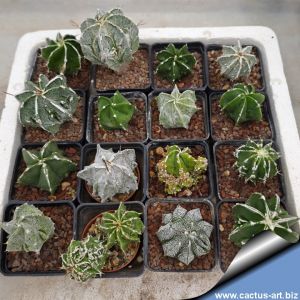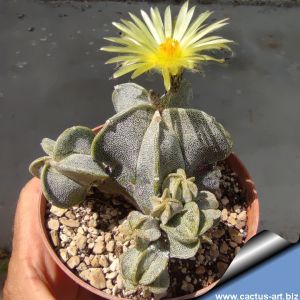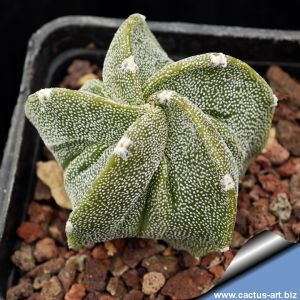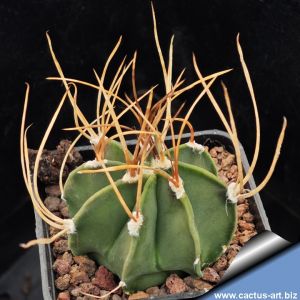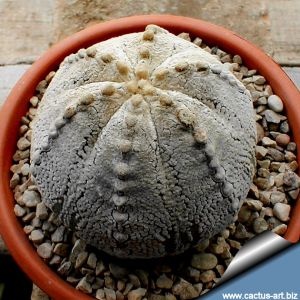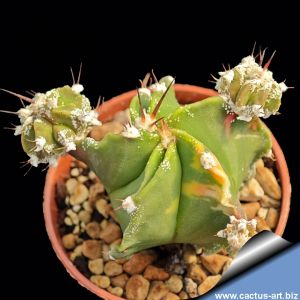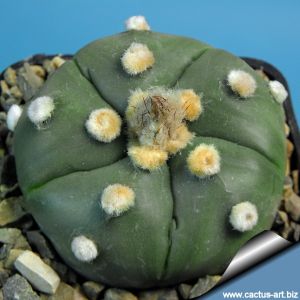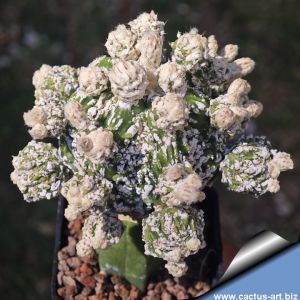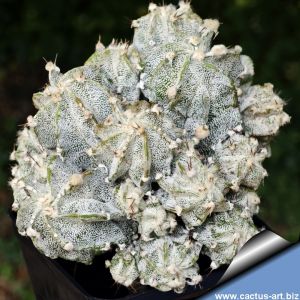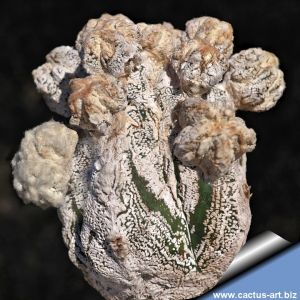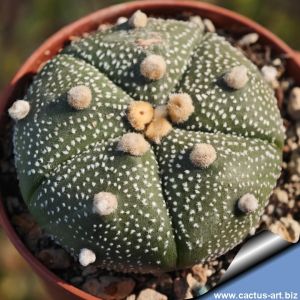-
1
Cultivar giapponese facilmente identificabile per le areole lanose interconnesse da una linea feltrosa lungo le costolature. L'epidermide liscia è di colore verde uniforme, senza puntini, il che esalta il contrasto con le linee chiare.
-
2
Questo ibrido unisce i tratti distintivi di A. myriostigma cv. ONZUKA, con corpo a cinque coste e grandi puntini bianchi, e di A. ornatum, dalle coste più acute e spine presenti nelle areole. Il risultato è una pianta con aspetto intermedio.
-
3
Forma speciale con sole 5 coste, caratteristica rara in Astrophytum asterias e molto ricercata dai collezionisti. Gli esemplari selezionati presentano anche grandi macchie tipiche del cultivar SUPERKABUTO. Ogni esemplare è diverso dall'altro.
-
4
Gli ibridi di Astrophytum caput-medusae hanno tubercoli più grandi, gialli e verdi, che in inverno acquisiscono una piacevole tonalità arancione, con una crescita vigorosa e robusta. Esemplari innestati, davvero splendidi.
-
5
Astrophytum myriostigma "tricostatum nudum" è una cultivar affascinante caratterizzata da sole tre coste e dall’assenza delle tipiche macchie bianche. L’epidermide liscia mostra tonalità variabili dal verde al verde-grigiastro o verde-malva.
-
6
Forma classica di A. asterias cv. SUPERKABUTO. Diametro 4-5 cm, piante da seme di cica 5 anni di età su radici proprie.
-
7
Esemplari selezionati di A. asterias cv. SUPERKABUTO, solo piante con grandi macchie bianche e disegni particolari. Diametro 4-5 cm, piante da seme di cica 5 anni di età su radici proprie.
-
8
Mix di forme e cultivar di Astrophytum capricorne, una specie estremamente variabile e dal fascino unico. Ogni pianta è diversa dall’altra, con corpi verdi o punteggiati in bianco e spine di diversa consistenza e colori.
-
9
Cactus di notevole bellezza e originalità, con corpo verde e lunghissime spine dorate, flessibili e sinuose. I grandi fiori gialli con gola rossa aggiungono un tocco spettacolare, completando l’effetto ornamentale.
-
10
Ibridi AS-CAP – Incrocio tra A. asterias (pianta madre) e A. capricorne (impollinatore). Fiori grandi con petali giallo-perla e gola rosso vivo. Coste rialzate ma con corte spine con la compattezza di asterias e la definizione di capricorne. Bellissime.
-
11
Bellissimi esemplari selezionati con sviluppo tetragonale (forma quadricostatum), dall’epidermide debolmente punteggiata che forma disegni elaborati. L’effetto visivo è elegante e ricercato.
-
12
Bella forma che differisce dal tipico myriostigma per il corpo liscio di colore verde brillante, infatti questa pianta è senza o con pochissimi puntini bianchi. Alcuni la considerano una forma estrema della ssp. potosinum.
-
13
L'Astrophytum ornatum è la specie più grande e facile da coltivare ed anche quella di crescita più veloce. Sferica da giovane diventa colonnare da adulta, alcuni esemplari sviluppano attraenti costolature a spirale.
-
14
Piante con epidermide verde e priva di puntini (nuda) che mette in risalto le areole bianche. Fiori grandi giallo-crema con riflessi madreperlati e gola rosso. Alcuni esemplari con fiori rosati.
-
15
L'Astrophytum capricorne v. niveum, dal nome latino "niveum" (neve), ha un corpo bianco ricoperto di puntini candidi che si intensificano al sole. Fiorisce abbondantemente in estate con fiori gialli e gola rossa, creando un affascinante contrasto.
-
16
Ibridi CAP-AS – Fusione tra A. asterias e A. capricorne: costolature leggermente prominenti e grandi fiori giallo-crema con riflessi madreperlati e gola rosso intenso. Piante variabili, dall’aspetto unico e affascinante.
-
17
Bellissima e distintiva, A. myriostigma quadricostatum fu descritto nel 1841 da M. Mittler come «pianta dal corpo rotondo-allungato con quattro costole». Si distingue dalla forma tipica, più comune, per avere quattro costole anziché cinque.
-
18
Fusto quasi completamente bianco, cosparso di fitti puntini bianchi che che creano un effetto luminoso. Splendidi fiori gialli risaltano magnificamente sulla superficie candida.
-
19
Astrophytum coahuilense with five ribs, has a surprising similarity to Astrophytum myriostigma. However, it is different in all characteristics regarding flower, fruit and seed. Flowers are yellow with a red center (like those of Astrophytum capricorne).
-
20
-
21
Astrophytum capricorne var. crassispinoides è una forma di A. capricorne var. minor con fiori giallo puro. Spine sottili, morbide, ricurve, color crema, giallo chiaro o beige. Bellissima e inconfondibile, anche senza fiori.
-
22
-
23
"Onzuka Ranpo-gyoku". ONZUKA has fabulous markings that varies considerably from plant to plant, and also plants change their appearance in age and they are full of surprises as they grows. The “quadricostatum” form has 4 ribs instead of 5.
-
24
-
25
Piante a 5 coste simili all'A. myriostigma, ma con fiori, frutti e semi diversi (simili all'A. capricorne). Il fusto è ricoperto da una fitta punteggiatura lanosa che dona un effetto "vellutato".
-
26
Hybrid A. asterias 'Superkabuto' x A. capricorne. This hybrid inherited large white spots from “Superkabuto”.The ribs are also noticeably raised, clearly indicating kinship with A. capricorne. The flower are also very beautiful.
-
27
"Fukuryu Rampowgyoku". FUKURYU is a Japanese word that would mean presence of additional ribs. It forms small extra ribs, usually these additional ribs have not areoles and develops on the lateral side sandwiched between two contiguous true ribs.
-
28
-
29
-
30
-
31
-
32
Questo cultivar differisce dagli ibridi OR-MY standard per l’assenza o quasi totale mancanza di puntini pianchi, mostrando un colore uniforme verde brillante, verde-blu, grigio-verde o verde-malva, a seconda dell'esemplare.
-
33
The woolly areoles on the ribs have a felty line between them so it seems like the areoles are connected with each other.
-
34
Corpo stellato verde, con zone variegate dal giallo al rosa-viola. Ogni pianta è particolare, con una combinazione di colori e pattern che la rendono unica.
-
35
Piante variegate con settori, chiazze o striature con due o più colori. Gli esemplari a corpo variegato sono molto ricercati. Ogni pianta è diversa e unica nel suo genere.
-
36
Astrophytum asterias is small, round, spineless and squat cactus. The disc-shaped body is divided into 8 ribs, greenish-brown and may appear speckled from its covering of white scales. The flowers of this cactus are yellow with red red bases.
-
37
Astrophytum myriostigma var. subnudum (partially naked form) is similar to A. myriostigma nudum, but deviates from it for having only a few white spots. The spots often form nice patterned designes on the dark green body.
-
38
-
39
Astrophytum asterias cv. Ooibo is similar to the standard A.asterias, but it has very large characteristic and woolly areoles. So it is easily distinguishable from the common asterias that has relatively small scarcely woolly greys-white areoles.
-
40
Astrophytum senile è una varietà di A. capricorne con splendidi fiori gialli e centro rosso. Le sue spine lunghe e flessibili sono così fitte da nascondere quasi del tutto il fusto, conferendogli l’aspetto di un fascio di erba secca.
-
41
Ibridi da impollinazione controllata tra ♀A. asterias "SUPERKABUTO" e ♂A. coahuilense. Tipicamente con 8 coste più affilate rispetto al "SUPER KABUTO" (segno dell'influenza del coahuilense), con un'affascinante copertura di larghi punti lanuginosi.
-
42
Varietà giapponese che unisce le enormi areole lanose tipiche degli "OOIBO" con l'epidermide verde puro del "RURI KABUTO". Un Astrophytum iconico. Piante da seme mai innestate.
-
43
NUOVO ARRIVO! Bellissima cultivar dalla Thailandia, caratterizzata da ampie macchie lanose che creano un pattern bianco brillante sulle coste. Quantità molto ridotte e nessuna certezza di nuove disponibilità.
-
44
Piante variegate con settori, chiazze o striature con due o più colori (crema, giallo, arancio o rosa su fondo verde). Le piante con il corpo variegato sono molto apprezzate. Estremamente variabili.
-
45
(Tipo B - HEKIRAN FUKURYU + RURI KABUTO) Il termine giapponese FUKURYU indica la presenza piccole protuberanze costolari laterali, prive di areole, che si sviluppano tra due costole principali. Mentre RURI si riferisc ai corpi lisci senza puntini.
-
46
This particular cultivar differs from the typical A. asterias due to the starry rather than rounded stem and the large felted areoles. The skin is dull green and smooth.
-
47
La varietà giapponese HAKU-JO si distingue per le areole ricoperte di una peluria lanuginosa, che creano una doppia linea feltrosa lungo le coste, facendo sembrare che le areole siano unite tra loro.
-
48
-
49
Rare variety that combines the irregular ribs of FUKURYU with the felt lines of HAKU-JO on the edge of the ribs. As the plants get older they become more and more beautiful.
-
50
(Tipo B - HEKIRAN FUKURYU) Riconoscibile per le tipiche escrescenze tra le costole. "Multicostatum" indica la presenza di 6-7 (o più) coste.
-
51
Rara selezione di Astrophytum che combina nella stessa pianta la forma a 3 coste (tricostatum) con le fitte macchie bianche irregolari, tipiche della puntinatura ONZUKA. Piante speciali, molto ricercate dai collezionisti. Ogni esemplare presenta un dise
-
52
Plants obtained by controlled pollination of Astrophytum myriostigma x Astrophytum ornatum. Ribs are sharp usually 5 (like in A. myriostigma) spineless or with variable spines. This hybrid are strong growing. The flower are also very beautiful.
-
53
Splendida variante della celebre cultivar Lotus Land, caratterizzata da una crescita esplosiva: produce nuovi germogli da quasi ogni areola!
-
54
Ibrido tra A. capricorne e A. asterias ‘Superkabuto’ che unisce le caratteristiche più distintive di entrambi i genitori: grandi macchie bianche dal ‘Superkabuto’ e le costolature in rilievo dal capricorne.
-
55
Selected form with very elongated tubercles. Graceful and distinctive. Grown from seed, quite variable. Japanese cultivar still quite rare in collection, seldom offered for sale.
-
56
Incrocio tra A. asterias "SUPERKABUTO" x A. myriostigma "ONZUKA". L’ibrido F1 mostra caratteristiche intermedie ed è piuttosto raro perché queste specie raramente producono semi vitali. Con il tempo, sviluppa motivi molto belli.
-
57
Un eccezionale ibrido tra Astrophytum caput-medusae e A. myriostigma, caratterizzato da tubercoli più corti e più robusti rispetto a A. caput-medusae. Estremamente raro, con disponibilità limitatissima. Esemplare innestato.
-
58
Thin, elongated tubercles, mottled with yellow and green, which take on a lovely pinkish-red hue in winter. Grafted plants, very beautiful.
-
59
Bellissimo cultivar giapponese con caratteristici chiazze bianche simili a nuvole sul corpo della pianta. L’epidermide è liscia e verde. L’effetto complessivo è grafico e delicato.
-
60
Un Myriostigma da sogno! I puntini cotonosi sono così fitti da formare una copertura continua che avvolge il corpo. L’effetto è delicato, elegante e ipnotico, con una texture uniforme e vellutata che cattura lo sguardo in ogni dettaglio.
-
61
Ibridi straordinari risultato di complessi incroci tra diverse specie di Astrophytum (es. asterias, capricorne, myriostigma) e mutazioni come Superkabuto, Onzuka o Fukuryu. Ogni esemplare è unico, con combinazioni imprevedibili di disegni, forme e colori.
-
62
Varietà particolare che si sviluppa ramificandosi, generando nuovi getti dalle areole e creando, col tempo, piccoli cespi.
-
63
Tipo A: foma con piccole costole extra parzialmente sviluppate. Di solito, queste piccole costole aggiuntive non raggiungono l'apice della pianta, non presentano areole e si sviluppano sul lato laterale, posizionate tra due vere costole contigue.
-
64
Pianta con costole affilate verde/bluastro a volte tinte di porpora e senza puntini bianchi. Spine giallo oro o ambra, lunghe e rivolte in tutte le direzioni, così fittamente avvolte a nido che il corpo è appena visibile e sembra un fascio di erba secca.
-
65
Spine lunghe di colore marrone-dorato e fiori gialli.
-
66
Questi ibridi di Astrophytum uniscono gli ampi punti bianchi dell'A. asterias "SUPER KABUTO" con la texture lanosa a “fiocco di neve” tipica dell'A. coahuilense. Le 5 coste simmetriche creano un equilibrio perfetto tra geometria e bellezza.
-
67
Astrophytum hybrid OR-MY (A. ornatum X A. myriostigma) nudo e variegato – Rari esemplari cespitosi a ramificazione naturale, con epidermide verde liscia. Le variegature crema, gialle o rosa, uniche in ogni esemplare, lo rendono un pezzo da collezione.
-
68
Noto anche in giapponese come Goryo (cinque costole)+ Ruri Kabuto- questa variante eccezionale ha solo 5 coste nude (vs le normali 8 ). Le plantule nude a 5 coste sono vere rarità botaniche, molto ambite dai collezionisti.
-
69
Questo è uno dei più bei cloni giapponesi, noto come "SAZNAMI". Le costole sono ricoperte di numerose increspature rilevate, ciascuna coronata da una linea quasi continua di feltro bianco. I germogli laterali creano una forma ricca e scultorea.
-
70
‘Snowy Peter’ è un ibrido di Astrophytum ottenuto incrociando A. myriostigma e A. ornatum. La sua caratteristica distintiva è la proliferazione simmetrica di germogli laterali che nascono dalle areole, un fenomeno assente in entrambi i genitori.
-
71
Ottenuto da complessi incroci tra A. myriostigma e altri taxa, questo cultivar si distingue per la fitta maculatura di puntini lanosi. I peli bianchi si accumulano in striature verticali ben definite, creando
un motivo unico e ricercato.
-
72
Eccezionale variante di Astrophytum asterias, distinguibile per la presenza di cinque costole anziché otto. Una peculiarità morfologica che la rende molto ricercata. Disponibilità estremamente limitata.


